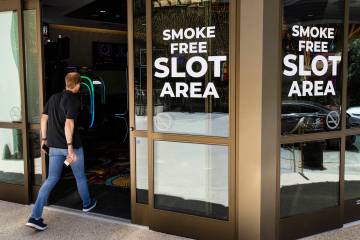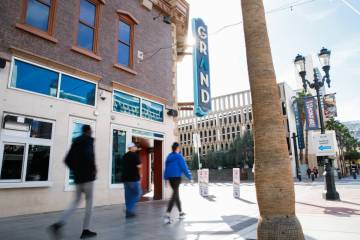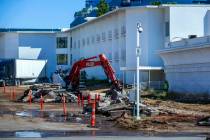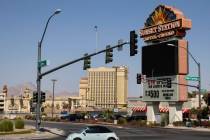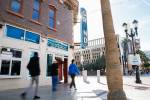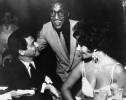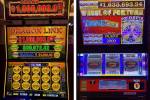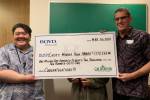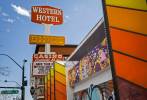Nevadan at Work: Developer has no doubt downtown will thrive
Real estate developer Andrew Donner has long believed in the revitalization of downtown Las Vegas.
Donner, who once had an office at the Neonopolis in the downtown mall's early years, bought the nearby Lady Luck casino in 2005, then promptly closed after announcing grand plans to remake it as a resort. But the path from the Lady Luck to buying another downtown landmark, the former City Hall, and leasing it to Zappos.com was littered with obstacles.
Donner has a list of lessons learned from the Lady Luck, which is majority-owned by CIM Group and only now taking shape as the Downtown Grand.
But Donner said he wouldn't change the experience. His involvement in downtown Las Vegas through the Lady Luck and development of the nearby Third Street block's bars and restaurants led him to Zappos.com CEO Tony Hsieh.
Donner called their first meeting in February 2010 "uncomfortable," but from that awkward discussion a business relationship, and later a friendship, were born. Hsieh had his eye on what was then City Hall. He sought Donner's help to create a Zappos campus in the heart of downtown.
Donner bought the building from the city for $18 million. The e-tailer is now set to complete its move downtown late next year, bringing thousands of employees with it.
Donner's company, Resort Gaming Group, works closely with Hsieh's urban redevelopment group, the Downtown Project, to acquire other downtown properties for the organization to use or lease to small businesses.
"We're friends first," Donner said. "We assist wherever assistance is needed."
Question: Why did you want the Lady Luck?
Answer: The hotel-casino, although it was a natural stream (from his work in food and beverage with Timbers). Really, the underpinning was urban redevelopment, even at that time. We started Third Street Promenade and those businesses. The reality was that the project just outgrew us from a capital standpoint, and that was why it was necessary to bring CIM into the market.
Question: Why were you interested in downtown to begin with?
Answer: It was coming from the Bay Area and loving an urban environment. It's what this city needed. I've always divided the city into two cities: There is this destination city, which is the Strip. I think of downtown as the walking city, where you can go to a variety of different places.
It was a little premature. The vision was right. I'm a marathoner, not a sprinter.
Question: Was your vision for the Lady Luck also premature?
Answer: It was the right vision. I believe it will still come to fruition. It's happening. It wasn't that it was premature; it grew to a size that was much larger than our checkbook could afford. The Lady Luck, no different than any other property, had challenges with its capitalization and that was why it was necessary to bring in someone like CIM that had the wherewithal financially, as well as the expertise to carry out the vision.
Question: How would you sum up your experience working on the Lady Luck?
Answer: I look at things totally different. Prior to that time, I was always looking at the upside scenario and never really respecting the downside scenario. Today, I've refocused my position to always look at the downside scenarios and weighing those against what the potential upside could be.
I think when we look back, I'm very happy with where we're sitting today as a company and the contributions we've made to downtown, how we've navigated the storm.
Question: How did you meet Tony Hsieh?
Answer: A mutual acquaintance introduced the two of us. It was a very uncomfortable meeting when we first met, only because Tony was not the most talkative person when I met him.
A couple weeks later, I get a text, and (Zappos executive Fred Mossler and Hsieh) asked if I wanted to take a walk downtown. They pointed at City Hall and they asked about the building. There was a comment made by Tony: "That would be a really interesting place for a corporate campus."
Having been involved with the Lady Luck, so passionate about the revitalization of downtown, understanding that the deal at City Hall was currently being led by Cordish and the stadium - I didn't have a lot of confidence in that proposal being put together. I took Tony's kind of flippant comment and started trying to put the pieces of the puzzle together.
Question: Did you connect the dots immediately when Tony made that comment about City Hall?
Answer: Yes, I connected the dots. The challenge was that the city was under contractual obligation with another company. That was a sensitive issue because there's certainly a need and a desire for an arena downtown. We had looked at City Hall before because of the proximity to Lady Luck. We were aware of the funding needs of that project. We felt that for the good of the city that we could potentially get both. Is there an alternative site that is more appropriate for an arena?
I tip my hat to Cordish as well. Certainly they were a participant in acquiescing in moving and being a good player to downtown.
Question: Details of the City Hall deal were widely reported, but what was it like behind the scenes?
Answer: Most people on the outside will only see the end-result, that City Hall was acquired and Zappos is coming downtown. I know that no one will ever appreciate that process. (It was) one of the most complicated, difficult transactions that has ever occurred, because there were several parties at the table.
There were several different points in that transaction where the deal could have fallen apart. I think it was the commitment of a lot of people - I was just one piece of the puzzle - and the tenacity of a whole army and everyone's commitment to seeing that it come together. The result is going to be one of the most transformational things that downtown has ever seen.
Question: How would you characterize Resort Gaming Group's partnership with the Downtown Project?
Answer: There are various acquisitions or developments or entitlement processes or things that are needed to do the entire revitalization project that we are called upon to assist with.
There's a lot of crossover. What Tony has taught a lot of people is that if you're not sensitive about who gets credit for a decision that needs to get made or something that came to fruition, if you're not sensitive of who gets credit, it's amazing what can get accomplished.
Question: What is your vision for downtown?
Answer: The biggest thing is being really focused on "return on community," not focused on "return on investment." If you really focus on what's best for the community, the pieces start to fall into place.
The balance is that there's just as much focus on the arts as there is small business, as there is real estate, as there is on education.
Our goal is to take what normally would occur in 15 to 20 years and accelerate it into five or seven.
Question: Is that return on community mindset a difficult one to adopt after coming from a finance background?
Answer: Yes. Tony is one infectious guy. I'm a believer.
Contact reporter Caitlin McGarry at cmcgarry@reviewjournal.com or 702-387-5273.
VITAL STATISTICS
Name: Andrew Donner
Position: CEO, Resort Gaming Group
Quotable: "Vegas (time) is like dog years. Six months here is three years somewhere else. What appears today (will be) dramatically different in six months."
Age: 45
Family: Wife of 13 years, Belinda, and four children.
Education: Bachelor's degree in communication from University of Colorado, Boulder, 1989.
Work history: Worked as a mortgage banker for Weyerhaeuser Mortgago Co. in Northern California until 1993, then transferred with the company to Las Vegas. Invested in Timbers Bar & Grill in 1995 and developed the restaurant into a chain. Worked as a commercial developer before buying the Lady Luck in 2005. Developed the Third Street block near Lady Luck, including Triple George and Sidebar (now Mob Bar). In 2005, founded Resort Gaming Group to manage the Timbers chain and Lady Luck and uses the moniker "for acquisitions and market presence going forward."
Hobbies: Working out, fly-fishing, being a father.
Favorite book: Walter Isaacson's "Steve Jobs" biography.
Hometown: Piedmont, Calif.
In Las Vegas since: 1993
Resort Gaming Group is at 300 Las Vegas Blvd. North. It can be reached at 953-4320.




